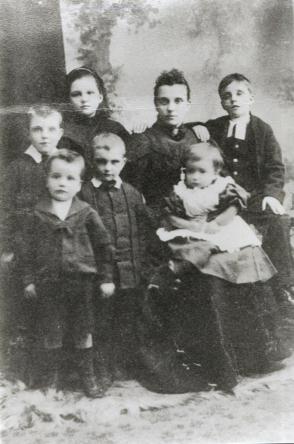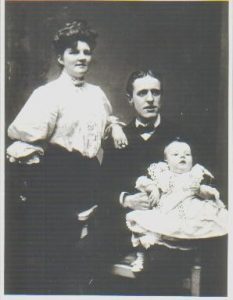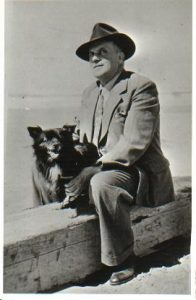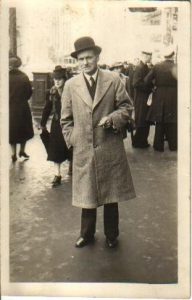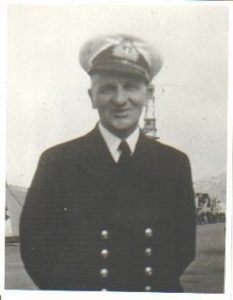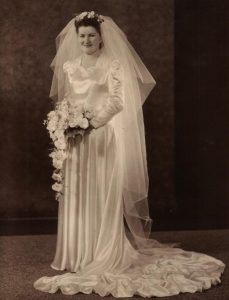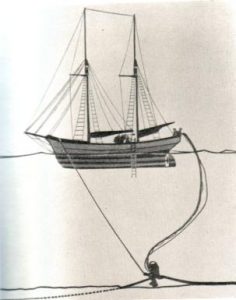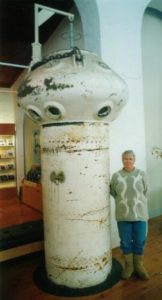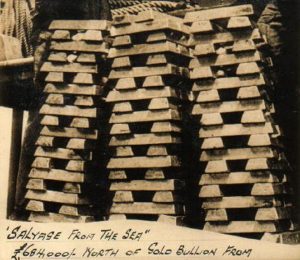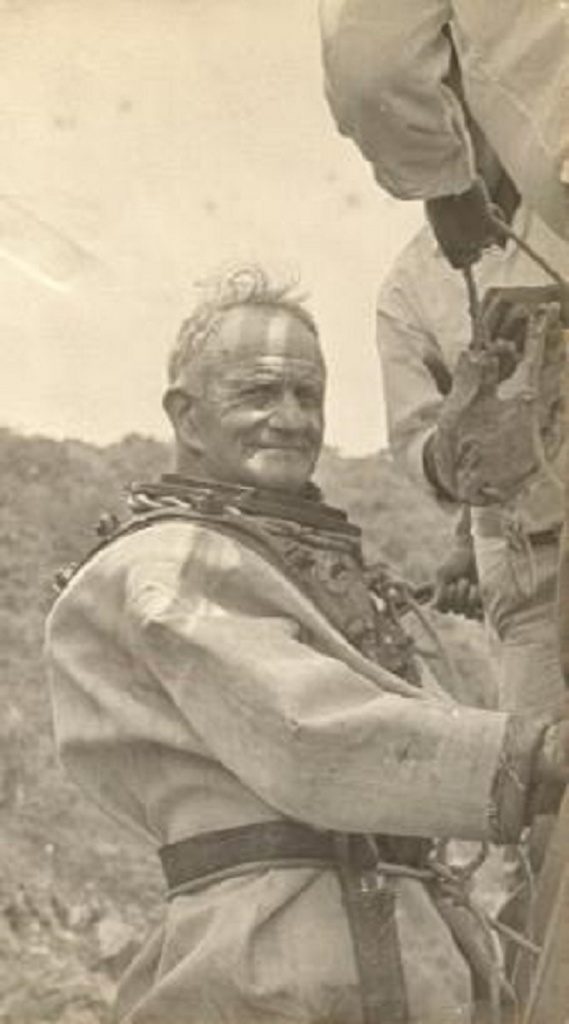I am Judith Kempen and this is my Johnstone Family.
This family is shrouded in mystery and try as I may I cannot find many forbears for us on this side of the family.
The family lived in Liverpool in England and my great grandfather was,CHRISTOPHER JOHNSTONE. He married ELIZABETH ALLEN.
He was a Joiner by occupation and they lived at 10 Trafalgar Place, Trafalgar Street, Liverpool. I have no other details on them. They had at least one son, James.
JAMES ALLEN born 10 July 1860 in County Lancaster.
He died 21 March 1896 after an accident to his hand, which developed into Tetanus. He worked as a storeman on the Docks. He married MARGARET LEE RUGINE? We have no further information on her except that her father was a deep-sea diver. She died in Liverpool in 1910.
The children of JAMES and MARGARET:
Back Row: Samuel, Lilian, Margaret, James; Front Row: John, Thomas, William (on knee) and Jessica (not in photo)
Back Row: Samuel, Lilian, Margaret, James
Front Row: John, Thomas, William (on knee) and Jessica (not in photo)
1. LILLIAN born about 1885 in Liverpool. She married a MOWBRAY and had a son ERNEST MOWBRAY. She had a hospital in Liverpool. (No further information on her family)
2. JAMES born about 1888. He had 2 sons, John Edward and Stanley. James drowned in New York Harbour in 1917 during World War I. He was 29 years of age. His descendants live in Jersey, Channel Islands.
3. SAMUEL was born 1890. He married Lillian Waller. They had two daughters, Doris and Edna. Their descendants lived in Liverpool. Samuel was killed in the Battle of Cambrai on 30 November 1917 in France in World War I.
4. THOMAS born about 1891. He married Anne Erie in Portland, Oregon USA. They had two sons. Robert Erie Johnstone and Thomas Andrew Johnston. Robert Erie married Betty Lou Nixon. Thomas Andrew married
Maryellen Findlay.
5. JOHN EDWARD born 25 September 1892 at 68 Smeaton Street, Kirkdale, Liverpool. He died 27 October 1976 at the East Melbourne Retirement Home. He married EDITH GILL on 26 June 1917 at Walton on the Hill, Lancaster. More of their story later.
6. WILLIAM born 8 January 1895 in Kirkdale, Liverpool. Died 19 September 1977 in Sydney Australia. He married Daisy Ethel Gyford on 13 October 1917.
They had 3 children. Gordon (infant death), Donald Gordon and Jean Mavis.
Their descendants live in Sydney and New Zealand.
7.JESSICA. Abt 1897. Her birth and death dates are unknown. She had one son, Ralph who married Doris Isaac. Their only child, Rodney, emigrated to Perth in Western Australia.
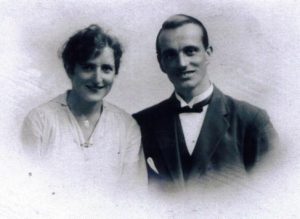
Edith Gill and John Johnstone
JOHN EDWARD married EDITH GILL daughter of NATHANIAL GILL and MINNIE(surname unknown).
They had three children. EDITH died 10 days after the birth of the twins of septicaemia.
PHYLISS JOAN born 5 June 1918 in Invergordon, Scotland. Died 1990 Boat Harbour in Tasmania, Australia. She married REGINALD SIGGINS. They had the following children; Helen Margaret, Edith Doreen, Mary Joan, John Robert, Regina Francis.
EDITH MAVIS DOREEN born 20 July 1922 at Williamstown, Victoria. Married KEITH WILLIAM JOHNSTON ON 27 July 1946 at Scotch College Chapel, Melbourne. Edith died 11th March 2014.They had one child, JUDITH KAY.
3. JOHN THOMAS EDWARD (Jack) born 20 July 1922 at Williamstown, Victoria. He married BEATRICE CARMEN CHAPAART in Adelaide in 1966. They had three sons, JASON ROGER, JULIAN SEAN, HARLEY DAVID. He died 3 March 2009.
After Edith’s death, JOHN married EDITH EMILY SMITH, born 13 March 1894, in Newport, Victoria. She was the daughter of ROBERT EDMUND SMITH and ELIZABETH ANN MILLARD. She died 10 November 1971 in Frankston, Victoria. She and John had one son, ROBERT DENYS (Bob) born 15 September 1928 in Armadale, Victoria. He married MARGOT RUTH SEMMENS ON 31 March 1956 in Melbourne. She was the daughter of SEGBERT GEORGE CORNWELL SEMMENS and GWENDOLINE ANNIE DURHAM.
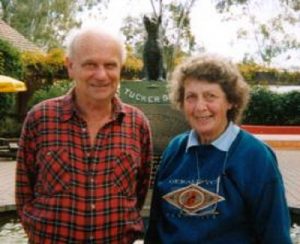
Robert and Margot
ROBERT and MARGOT have two children; PETER DURHAM and SUSAN RUTH.
Margot passed away in 2015
MY GRANDFATHER
JOHN (JOHNNO) EDWARD JOHNSTONE, MBE.
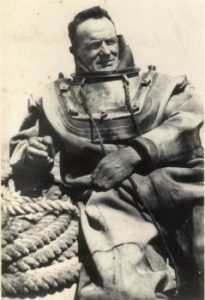
Johnno Johnstone 1950
He was to become a Deep Sea Diver of great renown. Some say the best, ever, in Australia.
His father died when John was 3 or 4 years old. He left school at 14 and worked as an office boy in a solicitors’ office (which he hated) and was sacked after six weeks. He then worked as an office boy in the Accounts Dept of the Canadian Pacific Steamship Company. He was sacked from this job as well. Even though his mother was against it, he was destined to go to sea. He found a position in a ship repair yard and became a shipwright’s apprentice, indentured for five years. Bill Russell was a diver on the Mersey River and trained him in the basics of diving.
John’s mother died when he was 18 years of age. Late in 1910 he became a carpenters mate on the cargo steamer ‘SS Cornwall’ and emigrated to Australia. He arrived in Sydney in January 1911 aged 19 years. He went to Taree (had to walk all the way as he had missed his train) and worked in a shipbuilding yard at Coopernook, on the Manning River. There he was employed by the Baskerville Family. He stayed with them until he had finished his apprenticeship and then went to Taree and worked for Danny Sullivan Boat Builders. Here he met Stan Mitchell and a lifetime friendship was formed. He also met Flo (Stan Mitchell’s’ sister), and would have married her but for the outbreak of WW1.
In 1915 he returned to Liverpool and became Private Johnstone of the 17th Kings Liverpool Regiment or 1st Liverpool Lighthorse (in the horse brigade, grooming horses) and was stationed at Salisbury not far from Stonehenge. When volunteers were called for to train as divers he did so immediately. Discharged from the army to assist the war-effort as a shipwright at Portsmouth Shipyards, he became a Divers Assistant to Dick Leverett and in 1916 he was sent to Invergordon in the North East of Scotland to start a formal course in Deep Sea Diving. Invergordon was an important Naval Base where ships of the Grand Fleet came for refitting. It was also the home of The Diving School, which was situated, in the old battleship “H.M.S. Mars”.
At the end of the three-month course he was presented with the following report. ” TO WHOM IT MAY CONCERN. The bearer, J. Johnstone, has been with me for three months as a trainee diver. I regret to say that his prospects as a diver are not good.” Signed R. BOWIE.
While training he was introduced to the American invention, an underwater gas blowtorch. He went on to master this device and became one of its most skilled operators. He worked off the Orkney Islands patching holes in torpedoed British ships. A condition of the German surrender was that the German Navy delivered their ships to Invergordon Dockyards; they delivered them and scuttled the lot. So they all had to be raised again. Johnno was engaged in the Naval Salvage Section. He lived with the Wallace family. Here he met and married Edith Gill in July 1917. Phyllis, their first child, was born at Invergordon Scotland.
In late 1918 he decided to return to Australia with his family and they came on the “Port Lincoln” which sailed to Melbourne via Fremantle in July 1919. In Melbourne he and Edith and baby Phyllis, settled in at Williamstown next door to the Robbins family. Here the twins, EDITH and JOHN (Jack) were born in 1922. EDITH JOHNSTONE (nee GILL) died two weeks after the birth of the twins and is buried in Williamstown cemetery. Edith’s best friend Edith Smith, became the carer for the children. John is listed as a Shipwright on the twins’ birth certificate. When the twins were toddlers, Johnno married EDITH SMITH.
Johnno decided to become a freelance diver and would take on any work. His business card read “Specialist in Submarine Oxy-Hydrogen Cutting and Explosives at Any Depth”.
In 1921 he worked for Lloyds of London salvaging the cargo of Silver from “SS Karitane” at Deal Island in Bass Strait. He worked on the wall at Eildon Weir for the State Rivers Department of Victoria. During this job he cut girders at a depth of 122 ft, the greatest depth at which a blowtorch had been used at that time.
In 1922 he went back to the “Karitane”. He recovered 454 tons of Blister Copper worth 50,000 pounds sterling.
In 1932 the “SS Casino” sank with the loss of 10 lives, at Apollo Bay. As he had done a lot of repair work on this ship he was called to inspect the cause of the sinking and found that in a large swell the ship holed itself on its own anchor. Johnno removed the propeller which was made of brass. He used 28 specialised hacksaw blades to remove it. He donated the propeller to the Port Fairy Community and today it is part of a monument in Port Fairy to commemorate the lives lost.
In 1938 he was engaged by the French Government to demolish the wreck “Julette” at Thio 180 miles from Noumea. Using explosives and underwater cutting gear he removed the wreck within 12 months, He raised her cargo of 3,000 tons of nickel and cobalt ore.
In 1935 the Post Master Generals’ Office laid the underwater telephone cable which ran from Melbourne to Tasmania. By 1939 it deteriorated due to the large swells on the sea floor. To find the damage Johnno was employed to walk along the cable under Bass Strait for some 27 miles at a depth of between 70 and 100 feet. The walk started in September 1939. It was during this time that Johnno took his first underwater photographs. The first under water photographs taken in Australia. He recorded every job on film after this.
In June 1940 the 14,000-ton passenger liner “Niagara” struck a German mine near the Hen and Chickens Islands and Johnson Point, 5 km from Waipu on the North Island of New Zealand. She sank. The ‘Niagara’ had been on a regular run between Sydney, Auckland and North America when she struck the mine. No lives (148 passengers and 203 crew) were lost but the gold from South Africa, in transit to America, to pay for the British War effort, was lost.
In 1940/41 Johnno was the Chief Diver responsible for raising the “Niagara” Gold. He and brother William (Bill), on loan from the Royal Australian Navy, raised 8 1/2 tons of gold bars worth 2,500,000 pounds sterling. The “Claymore” barge set out from Whangarei on the 9 December 1940, to search for the wreck. It was during this period that Johnno made a world diving record when in the observation bell, he went down to 528 ft. The “Niagara” was located on 2 February 1941.
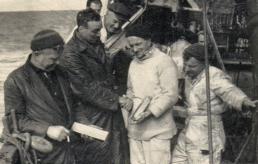
First Gold Bars
Regular diving suits could not be used as the depth of the ship, some 50 fathoms, was too great. A totally enclosed chamber was designed by David Isaacs, and built at the Thompson Foundry in Castlemaine Victoria. Today the “Bell” is on show in the Castlemaine Museum. I have copies of the original blueprints for the Bell. Johnno and Bill made a total of 316 descents in the Bell on the “Niagara”.
He travelled to Darwin in the Northern Territory and was working on American ships in Darwin Harbour on 19th February 1942 when Darwin was bombed by the Japanese. He was pulled out of the water and hid under a wharf and watched the bombs dropping.
In May 1942 Captain Williams, Captain Herd and Johnno established the “Commonwealth Salvage Board”. Johnno was the Chief Diver and Shipwright Surveyor. They worked in conjunction with the Australian Navy working on wrecks in Darwin and Melville Island. In April 1942 he travelled to the USA to obtain salvage experience and to see the latest diving techniques and also to purchase gear for the Commonwealth Government. During this visit he dived and worked on the “Normandie” a 79,000 ton ship that rolled over at the 48th Street Pier in New York. He also travelled to England, to study diving at the Siebe Gorman School for frogmen.
In 1943/4 Johnno assisted in raising the two Japanese Mini Submarines that had blown themselves up in Sydney Harbour. These submarines are on show at the Australian War Memorial in Canberra.
In 1944 Johnno was joined in New Guinea at Milne Bay by his son Jack and nephew Peter (Donald) The latter were both divers and just a few months out of diving school in Port Melbourne. Just after their arrival Johnno was sent to Townsville Hospital as he had contracted Malaria. He returned to Oro Bay to refloat the “Bantam” a gunship that had been bombed. There were many delays and work was stopped frequently by air raids. The ship had some 45 holes in the hull which to be sealed. The job was completed and she was
Johnno developed ear problems at this time. He had 1-week home with his family.
The next major job was in November 1944 when the “Santhia”, an 8,000-ton troopship, caught fire and sank at the No 3 Garden Reach Jetty in Calcutta. Here all the experience gained on the “Normandie” came into use. He worked here for 7 months and suffered from Dysentery. He returned to Australia 12 months after leaving for India.
In January 1947 the liner “Wagannella” stranded on Barrotts Reef at the entrance to Wellington Harbour, New Zealand. Johnno arrived in Wellington on 25 January 1947 and successfully refloated the ship by August the same year. He also refloated the “Reynella” that ran aground 100 miles south east of Samarai. It proved to be a difficult and dangerous job and he sent for Jack to assist with the refloat.
After WW2 he salvaged Japanese wrecks around New Guinea and the Solomon Islands. He worked for a Japanese company during this time.
In 1953 he worked once again on the “Niagara” and assisted a British Salvage Firm to retrieve another 30 bars of gold. The Iron Man Suit was used at this time.
During the 1950’s and 1960’s he held a series of Silent Film nights showing the feat of raising the gold. He travelled to many venues.
In 1960 he and son Jack went to Christmas Island and replaced the supports of the wharf. He made his last job and his last dive when he was 73 years of age.
He was a chain smoker of both cigarettes and cigars and was never without one in his mouth. When I was young they lived at Athelstone Grove in Ivanhoe, Melbourne. At this time I remember he was always away diving and salvaging wrecks in New Guinea and working at Christmas Island. He went to Japan for a six-month holiday and took Edith, who had never travelled outside Melbourne, with him. They were the guests of the Japanese salvage company that Johnno had worked for in New Guinea.
When he retired and they moved to Frankston on the outskirts of Melbourne. He restored and made furniture in his retirement and did fine French Polishing work and was a perfectionist in every work that he did. I stood in awe at the beautiful pieces that he produced. He loved horseracing and he and his brother Bill (when in Melbourne) and my father Keith, went to the races every Saturday. They would go by train and meet up at the racecourse. One race day Bill had Lady Luck against him and lost a fair deal of money. Despondent he walked out the gates with this family and kicked at a roll of paper lying on the ground. It turned out to be a wad of money dropped by some unfortunate gambler and all the Johnstone Clan went out to dinner that night.
Johnno was appointed a Member of the Civil Division of the Most Excellent Order of the British Empire M.B.E. on 22 May 1968.
He died at East Melbourne Retirement Home on
27 October 1976 aged 84 and is buried at Springvale Crematorium.
REFERENCES
Peter Dawlish, Johnno The Deep Sea Diver, George G Harrap & Co Ltd. This book was a gift. The signed edition reads; To Judith from Grandad “Johnno”.
Bob Johnstone, Family Member.
Margot Johnstone, Family Member.
Jeff Maynard, Niagrara’s Gold, Kangaroo Press 1996. Divers in Time, Australias untold history, Gelnmore Productions 2003. Both books have been autographed by the author.
Royal Australian Navy , Record of Service 7 Pages.
Castlemaine Historical Society. Copies of The Bell Blueprints.
Doreen Morris. Family Member
James Taylor, Gold from the Sea, Australian Publishing Company.
Regina Lewis, Family Member.
Hugh Edwards, Sharks and Shipwrecks, Lansdowne Press. The Niagra Gold Chapter, p.30
Jack Loney, Shipwrecks Along the Great Ocean Road, Tenth Edition. “Wreck of the Casino Page 59.”
James Taylor, Spoils from the Sea, George G Harrap & Co Ltd in ass with Australian Publishing Company.
Kathy Satchell. Family Member.
R.J.Dunn, Niagara Gold. A.H & A.W.Reed, Wellington, New Zealand.
Monica Foster and Peter Stone, Rabaul’s forgotten fleet, Oceans Enterprises, Yarram, Victoria
Rod Johnstone. Family Member.
Julie Baron. Family Member.
David Samuels. Family Member.
Nick Samuels. Family Member.
Rebecca Williams. Family Member.

